Finding Asbestos Inside Your Home
Lets look around inside your home for hidden Asbestos
Typical locations for the most common asbestos containing materials around the home.
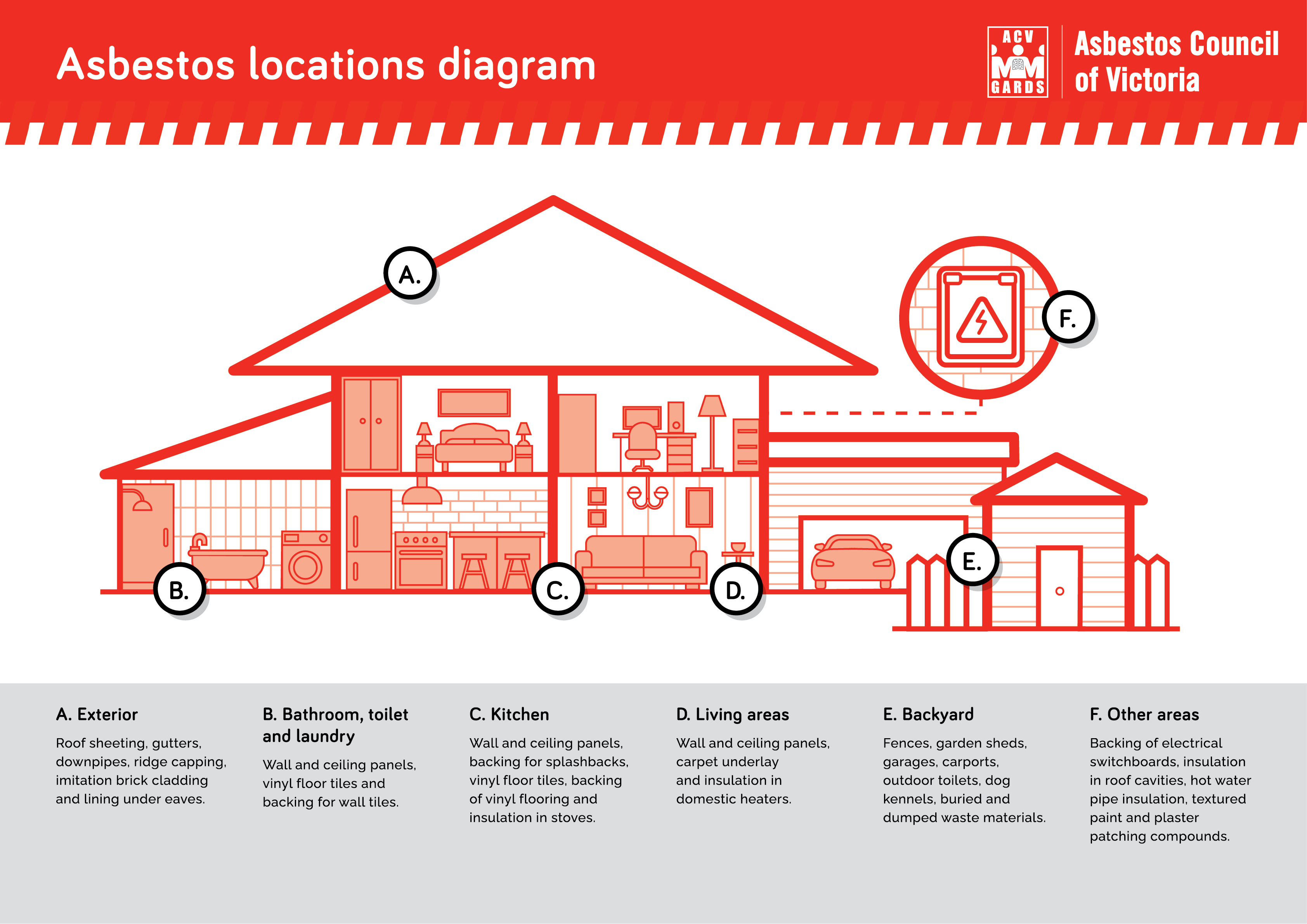
Floor
Take a look at the floor coverings in each room. They might all be the same or similar, now, but you never know if the latest covering was laid directly over the top of an older one. It is very common to find multiple layers of floor covering to investigate. There might also be layers of asbestos cement sheet or other materials between the layers of vinyl.
You could go to the centre of the room and cut a big hole to investigate but that will probably get you in a bit of trouble. Scout around the edges and corners to find locations that are easier to lift. Sometimes you may even have original floor coverings loose in the bottom of a cupboard or lining the shelving.
You will be looking for Vinyl Tiles, Vinyl Sheet with paper or millboard like backing or even black adhesive (Blackjack) used to glue these items to the floor. All these products could potentially contain asbestos.
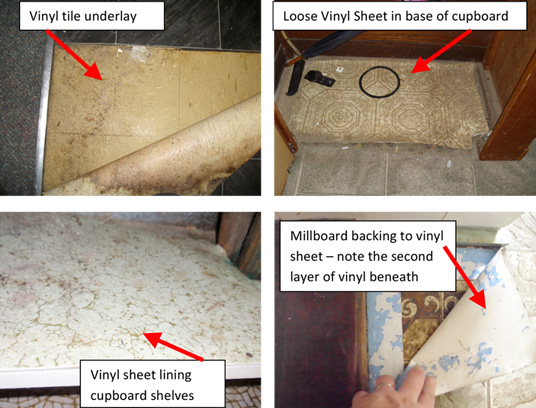
Asbestos containing floor coverings or underlay’s were more commonly (but not exclusively) located in wet areas of the household (Bathrooms, Kitchens the Laundry etc).
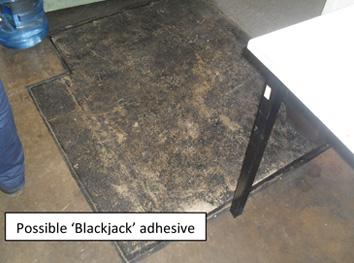
Perhaps there are some suspicious tiles and/or vinyl sheet that hasn’t been covered over! Below is an example of it still being used on the floor and the stair facing.
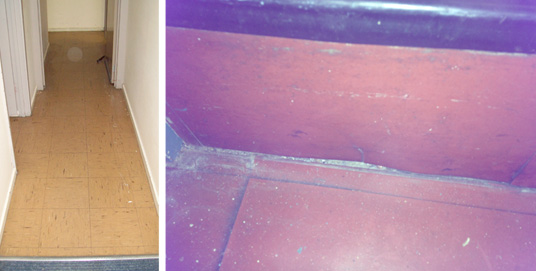
These products stuck to the floor better if it was a nice flat smooth surface and the nice flat smooth surface could be a nice flat smooth piece of AC sheet. It was quite common for AC sheet to be placed on timber or concrete floors for the vinyl products to be sealed onto.
Be aware that it can be very difficult to determine whether or not these products contain asbestos. Even under a microscope it can be inconclusive until the vinyl has been ‘cooked’ away. If unsure, take a sample using necessary precautions, to be analysed at an approved laboratory.
Walls
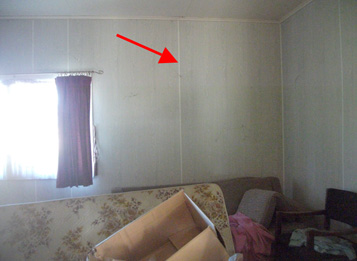
Now, walls can be an amazing mix of products! So many effects have been introduced over time to personalise a home. Chair rails, dado rails, picture rails, textured looks, false panels, removal and insertion of doorways and windows, room extensions, heater changes, repair patches – well, you get the point. Once painted, it’s easy to be tricked into thinking that everything is the same product. You must remember that asbestos cement products were moulded into all sort of shapes.

Familiarise yourself with each room individually, never assume that two rooms are the same without checking a couple of things first.
Walk into the room and assess the texture of the surface – is it all the same; are there lines where a repair patch might have been inserted; is it smooth all the way, or are there cover straps over the joins; can you see nail heads sitting just above the surface; is there a chair rail or picture rail, of some fashion, dividing the lower from the upper wall sections.
There may also be mouldings in the corner. These may be curved and look like modern ‘quad’ or it may be an L shaped moulding.
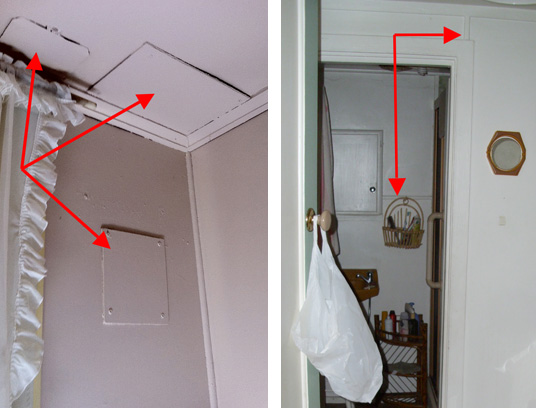
Grab yourself something solid, like a decent sized screwdriver, and begin a ‘GENTLE’ tap test – try not to get too crazy, unless you were planning on repainting soon anyway! Tapping in different locations can assist the identification of building product changes. You will notice that some areas sound like a soft ‘thud’ while others can sound quite ‘sharp/solid’. It is a good idea to tap the bottom section (around knee height) AND the upper section (around head height) of each wall.
It is usually the ‘sharp/solid’ sounding products that require further investigation, especially if it has signs of raised nail heads, cover straps, etc. Masonite, Cement Sheet and AC Sheet can all fall into this category. Masonite can be easy to eliminate from suspicion as it is a processed timber product. It has a very dark brown colour to it, however, to assess this fact you need to disturb the integrity of the sheet. There is a risk involved when doing this and necessary precautions need to be taken.
Another thing to be mindful of, some of the old style internal air vents were Moulded Asbestos also!
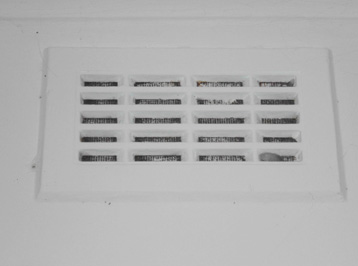
Remember that just like with the floor, however not as common, there may be multiple layers to the walls. Look for any ‘tell tale’ signs that may indicate this such as pine lining boards which may be hiding the original asbestos cement sheet wall – as seen in this picture.
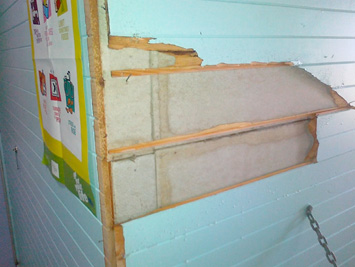
If you have access to see the back of the wall sheet you may be lucky enough to see ‘Does not contain Asbestos’ stamped on it! It’s generally not that easy though! Just because ‘Asbestos’ isn’t printed on it certainly doesn’t mean it’s not asbestos.
If you can see the internals of the wall you should also be on the lookout for any ‘tape’ wrapped around pipes. Asbestos Tape was used for insulation, sound elimination and repairs in plumbing and for its fire proofing with electrical wires.
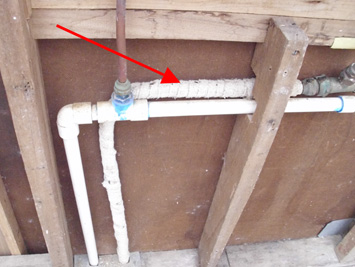
While we’re looking at the walls let’s also look at what some of their other ‘features’.
Heaters
We will start with heaters. AC Sheet was a great material to be utilised around heat because of its fire resistant properties. Asbestos has been found in (but not limited to) the products used for the following:
- Fire Pit Base
- Fire Surround
- Fire Place Features
- Fire Place Features Backing Boards
Fire Place Infills:
- Heater Backing Panel
- Heater Base Panel
- Heater Seals
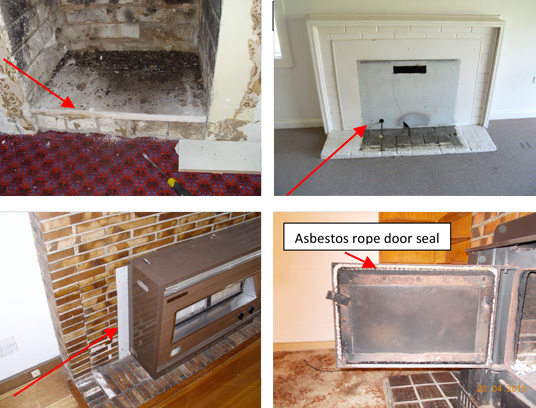
Ovens and Chimneys
AC Sheet was also commonly used to seal off a chimney. A good example of this is when the chimney has been sealed off to house an oven. There may be a cement sheet used to cap off the hole only or there may be a full surround installed.
Flues
Be aware that there are still a few asbestos ‘flues’ in use also. These were used for heaters but also for hot water services as shown in these photos.
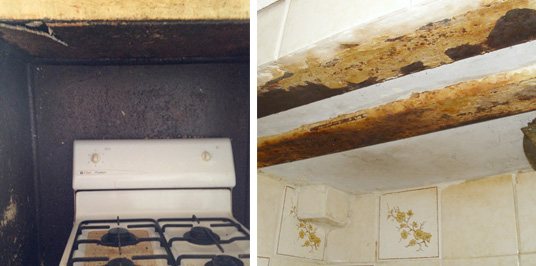
Often the existing flue was kept even when the hot water service was replaced.
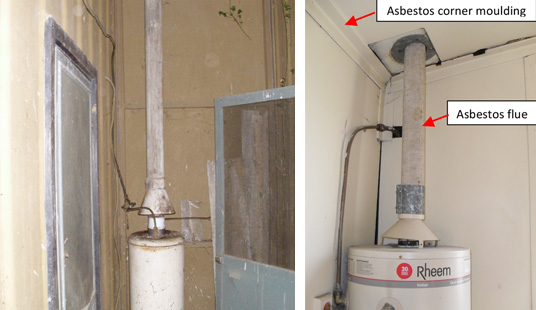
Wet areas
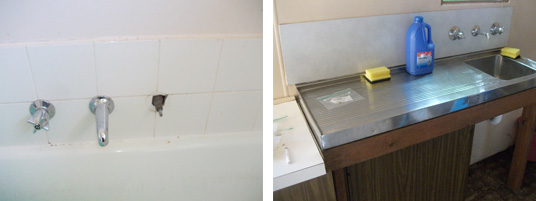
Wet areas are a prime location for asbestos products. Behind sink splashbacks, feature panels in bathrooms, bath hobs, bath aprons, bath surrounds, etc. The asbestos can be in the product you can see and/or hiding behind it.
A good example to start with is this bath surround. Clearly these are ceramic tiles but when the tap has been removed it can become evident that the tiles have been mounted onto a cement sheet – this could be an AC Sheet. Where possible, unscrew your taps and have a look, this saves flicking the tiles off!!
Here is an example that would require both the splashback and, if present, the cement sheet behind it, to be checked.
In a lot of cases a splashback like this is only Lamipanel (non asbestos) however, Tilux is very similar and that does contain asbestos. Far better to err on the side of caution and get it checked!
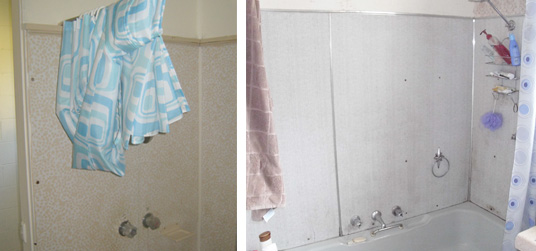
Want a little more info?
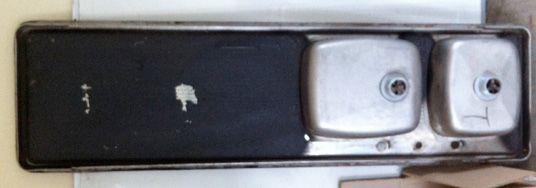
Tilux is effectively a thin asbestos cement sheet with a plastic like coating/laminate. Tilux is generally NOT highly shiny.
Lamipanel is a laminated timber product. Most of the time the Lamipanel has a high shine and almost looks like it is merely a big sheet of plastic.
One more, uncommon and very surprising find is the presence of a bituminous lining used underneath a sink as insulation. This is usually glued under the draining board but can extend to the sink bowls as well. Some of these were an asbestos containing material.
Ceiling
Now it’s time to look directly above at the ceiling. As with the walls, assess the texture of the surface – is it all the same; are there lines where a repair patch might have been inserted; is it smooth all the way, or are there cover straps over the joins; can you see nail heads sitting just above the surface; is there a vent cover or a weird light mount?
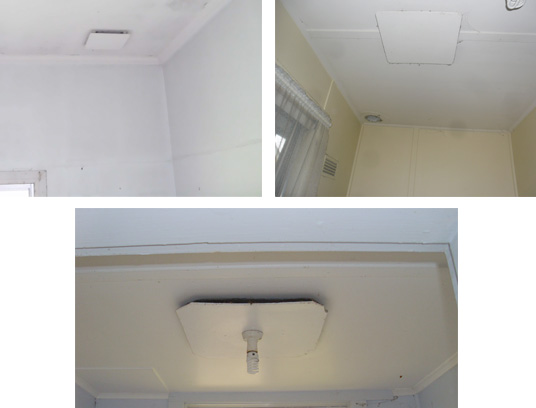
The ceiling itself may be asbestos cement sheet. The cover straps if present may be asbestos cement and the patches, light bases and vent covers may all be formed from moulded asbestos cement.
Grab that screw driver again, and conforming with ALL safety guidelines for use of ladders, perform a ‘Tap test’ for each different surface identified. If it has the ‘Sharp’ sound it will need further investigation.
Ceiling cavity
So at long last we come to the grand finale ………… the ceiling cavity.
Time to toughen up, push the thoughts of mice and spiders aside, grab the ladder again and take a look at that little square in the ceiling that you have always tried to ignore!
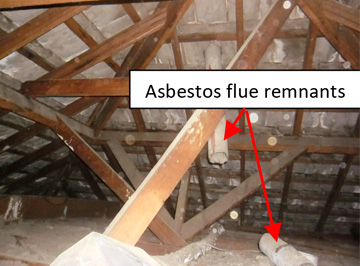
Now please take these following hints from someone who learnt the hard way;
Place the top of the ladder slightly to the side of the hole to avoid being covered in any debris that might fall out of the hole.
Lift the cover keeping it horizontal, if you tip it you will probably get an unexpected ‘debris’ shower and be doing the ‘ewww, get it off, get it off’ jig in no time.
I don’t like surprises in my face so I send my phone up through the hole first and take some photos. Once I’ve checked those, to make sure there are no rodents ready to pounce, then I put my head up into the ceiling cavity!!
The manhole cover is the first thing you will need to assess. The ‘Tap’ test; is it ‘Sharp’ or a dull ‘Thud’? Check the edges, if they are raw you may be lucky enough to define the material used by the colour or texture. Unless it is in really bad condition, you are wanting to cut it up or need to dispose of it, you really don’t need to worry about this. It will sit there being ignored for as long as you like! Builders liked to use cement sheet for manhole covers because the edges would stay solid whereas the edges of a plaster square would start to break up after you had pushed it up a few times.
So once you have taken a big breath and stuck your head up into the ceiling cavity, and realised that your imagination was far worse than the reality, start to look for the sneaky Tradesman/Handyman signatures like:
- Old flues that were not removed completely
- Random pipes
- Formwork under old (or current) Hot Water Services
- Loose sheets and off cuts of cement sheet
- Look closely at any current flues, chimneys, etc
- Roofing material on the underside of the roof that is different to that visible outside – the old asbestos roof may have been covered with a metal roof.
- Packers above roof beams.
Ceiling Insulation
Most houses are not insulated with asbestos containing materials. Some of the most common insulation products are the ‘batt’ type materials (‘pink batts’, ‘yellow batts’, ‘tuff batts’ etc). These are a synthetic mineral fibre or rockwool product and do not contain asbestos.
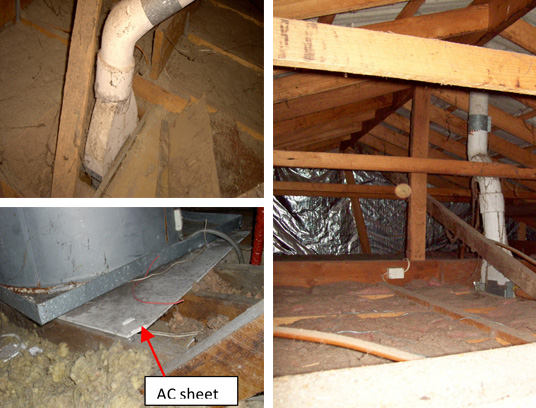
Loose fill insulation products are usually either wool or cellulose based products. Some of the loose insulation was made from recycled, shredded paper treated with a flame retardant.
In Australia there has been a lot of media attention relating to a company known as Mr Fluffy which used loose fill asbestos insulation in and around the Canberra area.
It is also possible that you have a house insulated with asbestos blanket material obtained by a worker from a power station.
If your house has or had an asbestos cement roof, the insulation material may have some contamination from this, especially if the person doing the removal of the roof was not careful.
If you have any concerns about your ceiling insulation it may pay to get it checked. We do not recommend sampling this area yourself due to the friable nature of asbestos insulation products. Get advice from a professional.
What next?
So, even if you were lucky enough to not find any suspicious materials, I bet you have learnt a lot of things about your home that you just never noticed before!
If you did find some suspicious materials don’t despair! If the sheet is in good condition then potential fibres are safely contained. Provided, that is, that you don’t take a hammer, saw, sand or drill to it of course!! If you have any raw edges where the sheet has broken, etc, seal it by applying a thick layer of PVC glue or paint for the interim.
For further confirmation of suspicious materials you could look into the following options:
- Sample collection
- Sample analysis by registered laboratory
- Asbestos Audit of your home by a professional
Just remember, Asbestos is NOT lurking around the corner of the house waiting to pounce at you like next door’s cat! It is more like a snake, if you don’t disturb it then in most cases it won’t attack you!!
It is still a snake though and dangerous – so know your facts and treat it with respect at all times!
For an interactive tool to help identify asbestos in your home, visit asbestos.vic.gov.au >
Find asbestos outside your home
Find out where you might find asbestos outside your home.
Thank you to Mairin OHS&E for providing this information for us. For help to confirm anything suspicious you have found around your home please contact Mairin OHS&E at their website www.mairin.net.au or phone 03 5127 2311.
